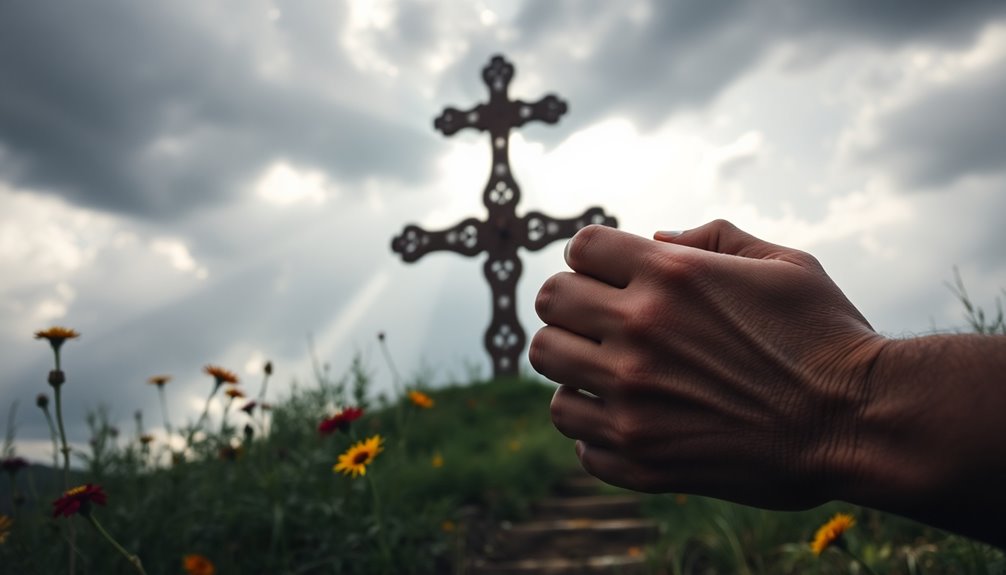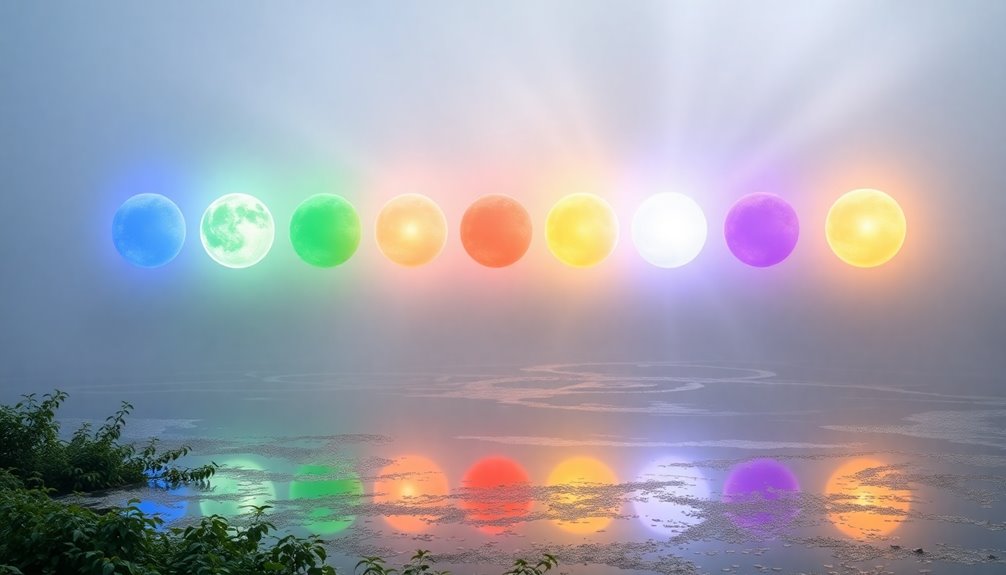On the first day, God created light, separating it from darkness. On the second day, He formed the sky, dividing the waters. The third day brought dry land and vegetation, including plants and trees. On the fourth day, God made the sun, moon, and stars to govern time. The fifth day saw the creation of marine life and birds, commanding them to multiply. Finally, on the sixth day, animals were created, culminating with humans made in His image. Each day had a purpose, and there's a fascinating depth to this account that you might find intriguing.
Key Takeaways
- Day 1: God created light, separating it from darkness, naming them "Day" and "Night" (Genesis 1:3-5).
- Day 2: God established the firmament, dividing the waters and naming it "Heaven" (Genesis 1:6-8).
- Day 3: God gathered waters to reveal dry land and commanded vegetation to grow, including plants and trees (Genesis 1:9-13).
- Day 4: God created celestial bodies, including the sun, moon, and stars, to govern time and mark seasons (Genesis 1:14-19).
- Day 5: God created marine life and birds, commanding them to multiply and fill the waters and skies (Genesis 1:20-23).
Introduction
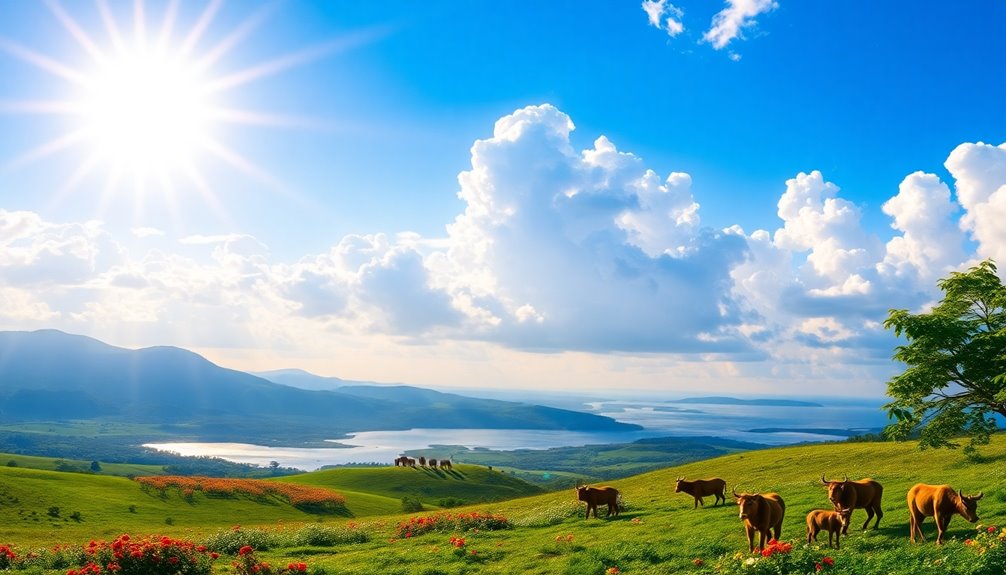
When you delve into the story of creation, you'll find a profound narrative that unfolds over six days, each filled with purpose and significance.
God created the universe with intention, starting with light on Day 1, separating it from darkness and establishing the rhythm of Day and Night. This act set the stage for the unfolding of life.
On Day 2, God created the firmament, which divided the waters above from the waters below, naming it Heaven. As the days progressed, the creation continued to flourish.
On Day 3, God gathered the waters to reveal the dry land, naming it Earth, and commanded it to produce vegetation, laying the foundation for a vibrant ecosystem.
Day 4 marked the creation of celestial bodies—the sun, moon, and stars—designed to govern the day and night and to mark the passage of time.
Finally, on Day 5, God created marine life and birds, commanding them to be fruitful and multiply, filling the waters and skies with life.
Each day of creation reveals God's artistry and intention, leading to a world teeming with diversity and beauty.
Creation Sequence in Genesis
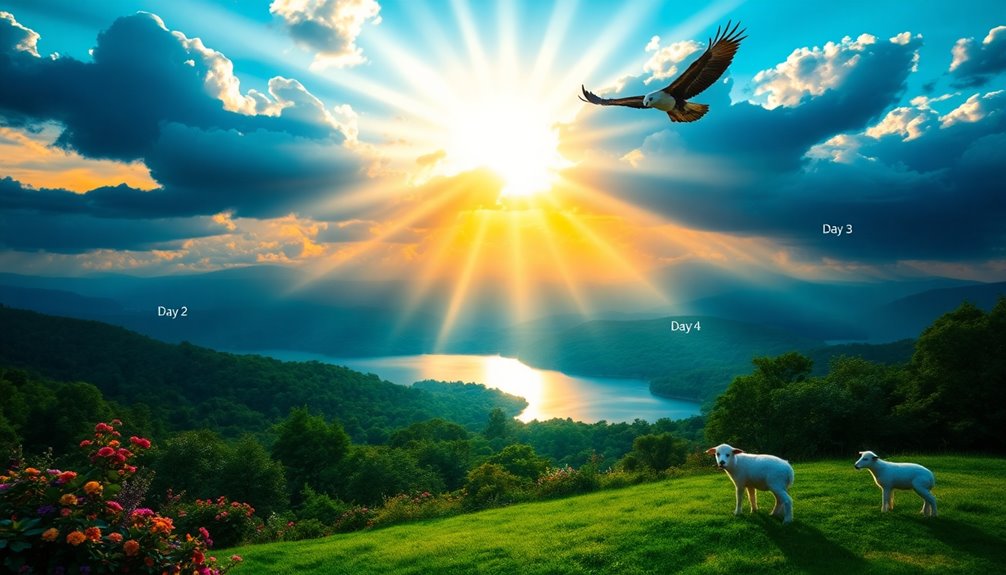
In the Creation Sequence in Genesis, you'll see a clear outline of God's creative work over six days.
Each day introduces remarkable elements, from light and land to living creatures, all rooted in specific Bible references.
Let's explore both the primary and secondary references that highlight this incredible account.
Primary Bible References
The creation sequence in Genesis presents a structured account of how God brought the universe into existence over six days.
On the first day, God created light, separating it from darkness and naming the light "Day" and the darkness "Night" (Genesis 1:3-5). This act established the rhythm of time.
On the second day, God formed the firmament, creating a division between the waters above and the waters below, naming it "Heaven" (Genesis 1:6-8). This separation set the stage for the Earth to emerge.
On the third day, God gathered the waters to reveal dry land, calling it "Earth." He commanded the Earth to produce vegetation, including plants and trees, which began to cover the landscape (Genesis 1:9-13).
On the fourth day, God created the celestial bodies, including the sun, moon, and stars. These lights were meant to separate day from night and mark the seasons, days, and years (Genesis 1:14-19).
Finally, on the fifth day, God created marine life and birds, blessing them to be fruitful and multiply (Genesis 1:20-23). Each act reveals God's intentional design in creation.
Secondary Bible References
Numerous secondary Bible references enrich our understanding of the creation sequence in Genesis, highlighting the significance of each day.
On the first day, God created light, separating it from darkness, establishing the cycle of day and night. This foundational moment emphasizes the power of God's word, bringing order from chaos.
The second day saw God creating the heavens by forming the firmament, which separated the waters above from those below. This act not only defined the sky but also set the stage for what would come next.
On the third day, God gathered the waters to reveal dry land, naming it Earth, and commanded it to produce vegetation. This flourishing of life marks a vital stage in His creation plan.
The fourth day introduced the sun, moon, and stars, which God created to provide light for Earth and to mark time and seasons.
Finally, on the fifth day, God created living creatures in the water and birds in the air, blessing them to be fruitful and multiply.
Each of these references deepens your appreciation for the divine order and intentionality behind creation.
Ancient Near Eastern Cosmology

Ancient Near Eastern cosmology paints a vivid picture of the universe as a flat Earth beneath a solid dome, known as the firmament. This firmament separates the chaotic waters above from the dry land below, reflecting a worldview that sees order arising from conflict with chaos. In many creation narratives from this region, gods battle primordial chaos to establish the world, emphasizing a polytheistic approach to creation.
In stark contrast, Genesis offers a monotheistic perspective, where one God commands creation into existence with authority. Instead of engaging in divine conflict, this God creates ex nihilo, or from nothing. This concept sets Jewish cosmology apart from other cultures that viewed creation as merely organizing pre-existing chaos or materials.
The firmament in Genesis also mirrors the Ancient Near Eastern belief that it regulates weather and separates waters, as seen in Genesis 1:6-7.
Thus, while both narratives address the cosmos, the approach to creation in Genesis is unique, emphasizing divine sovereignty and order without the chaos-driven strife found in other myths. Understanding this distinction enriches your appreciation of the biblical creation account.
Creation's Purpose and Order
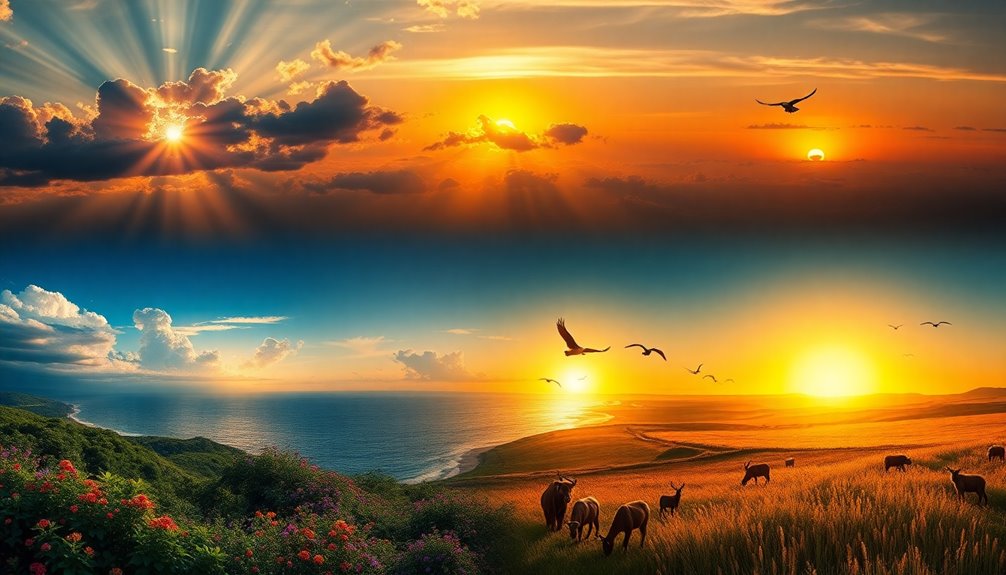
In understanding creation's purpose and order, you can see how each day of Genesis unfolds with intention and design. From the very beginning, God created light, separating it from darkness on Day 1. This act established the rhythm of day and night, a fundamental aspect of life on Earth.
On Day 2, the firmament formed, dividing the waters above from the waters below, creating the heavens and providing a space for life to flourish.
Day 3 reveals further purpose as God gathered the waters to unveil dry land, named Earth. Here, He commanded the earth to produce vegetation, with plants and trees essential for sustaining life.
On Day 4, God created celestial bodies—the sun, moon, and stars—to govern the cycle of day and night, marking the passage of time and seasons.
Creation Timeline Confusion
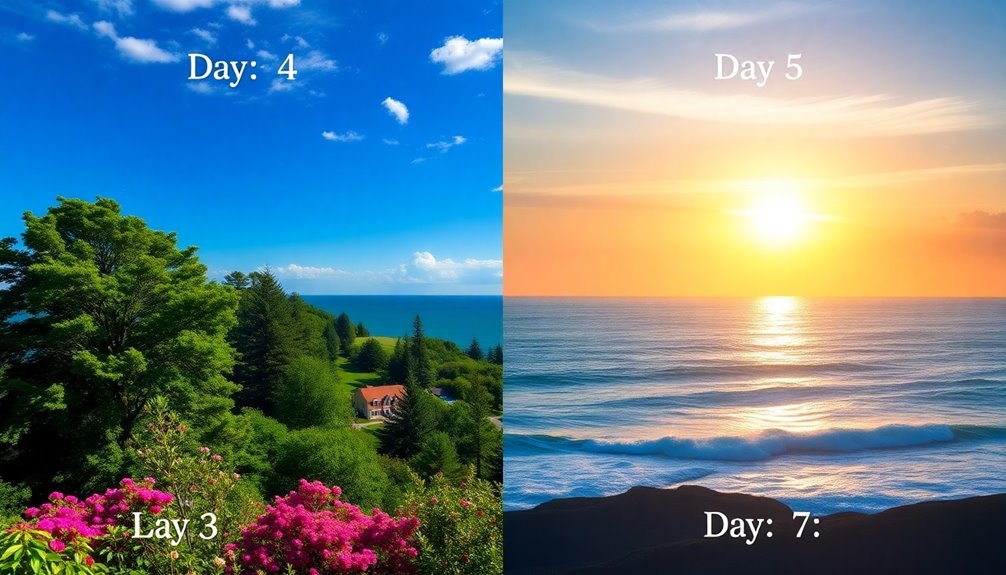
You might find it puzzling how the creation accounts in Genesis can present conflicting timelines.
While some interpretations lean toward a literal reading, others suggest a more symbolic understanding that raises questions about how these narratives align with scientific timelines.
Let's unpack these misconceptions and explore the distinct differences between biblical and scientific perspectives on creation.
Debunk Common Creation Misconceptions
Throughout history, many have grappled with the creation timeline presented in Genesis, leading to widespread misconceptions. Many people interpret the Genesis narrative as a strict historical account, but it's essential to recognize that the creation account unfolds over six distinct days, each representing a phase of creation rather than a literal 24-hour period. This framework conveys completeness, emphasizing God created everything purposefully.
Misunderstandings often arise from the portrayal of human creation. In Genesis 1, humans are created on Day 6, following land animals. However, Genesis 2 focuses on Adam and Eve's creation first, which can confuse readers about the timeline. It's important to view these accounts as complementary rather than contradictory.
Additionally, the seven-day structure in the Old Testament isn't meant to conflict with scientific understandings of Earth's age or species development. Instead, the theological messages in Genesis serve a different purpose than scientific explanations.
Scientific vs. Biblical Timelines
Understanding the differences between scientific and biblical timelines can be challenging, especially when trying to reconcile the two perspectives on creation. The biblical account in Genesis describes a six-day creation process, culminating in a day of rest, while scientific estimates suggest the Earth is about 4 billion years old. This stark contrast raises questions about the meaning of the "days" mentioned in Genesis.
Some interpret these days as literal 24-hour periods, while others view them as symbolic of a more extended process of creation. In Genesis, light appears on Day 1, followed by sky, land, and vegetation on Days 2 and 3, celestial bodies on Day 4, marine life and birds on Day 5, and finally, land animals and humans on Day 6. This sequence positions humans as the final act of creation.
In contrast, the scientific timeline posits that dinosaurs roamed the Earth long before humans emerged, complicating the relationship between faith and science.
This ongoing discussion emphasizes the importance of contextual interpretation of the Genesis account, allowing for a deeper understanding of both scientific and biblical perspectives on creation.
Environmental Stewardship Principles
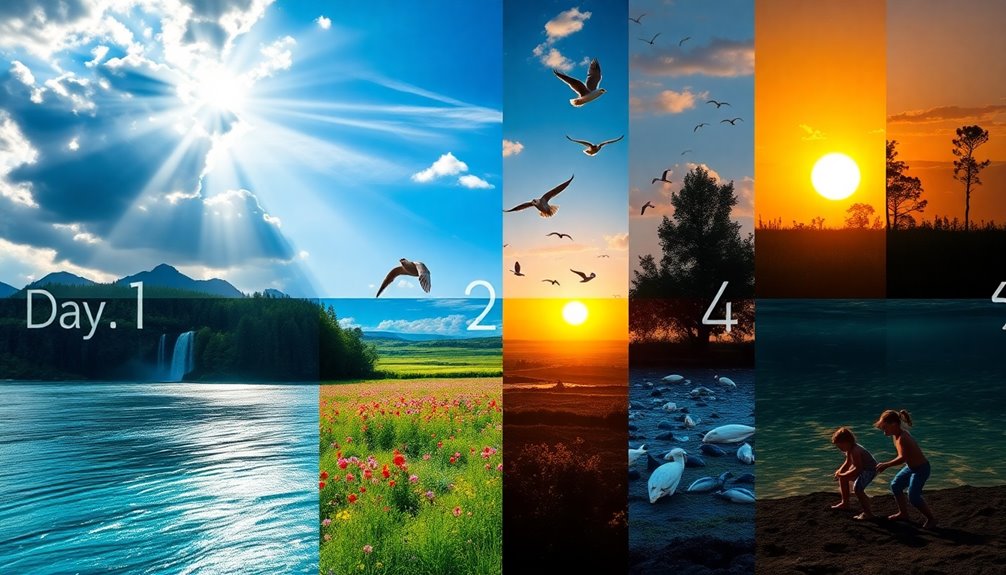
As you explore environmental stewardship principles, consider how sustainable living practices can transform your daily choices into acts of care for creation.
Community gardening initiatives not only provide fresh produce but also foster connections with your neighbors, reinforcing a shared responsibility for the earth. Additionally, engaging in eco-friendly toy selection can enhance your family's commitment to sustainability while providing educational benefits for children.
Sustainable Living Practices
Sustainable living practices frequently focus on reducing waste and conserving resources to protect our environment. You can start by composting organic materials, enriching your soil while minimizing landfill contributions.
Implementing energy-efficient technologies, like LED lighting and solar panels, will lower your energy consumption and cut down your carbon footprint.
Consider adopting a plant-based diet or reducing your meat consumption. This shift can significantly lower greenhouse gas emissions, as animal agriculture heavily impacts climate change.
Additionally, utilizing public transportation, carpooling, or biking instead of driving plays a crucial role in decreasing individual carbon emissions and improving air quality.
Practicing mindful consumption is another essential aspect of sustainable living. By choosing eco-friendly products and supporting sustainable brands, you'll promote environmental stewardship and help reduce the depletion of our natural resources.
Remember, every small action contributes to the greater good, reflecting the principles found in the creation story of Genesis, where care for the Earth was a vital aspect of humanity's purpose.
Embrace these practices, and you'll be playing an active role in protecting the beautiful world we've been given.
Community Gardening Initiatives
Community gardening initiatives serve as powerful tools for promoting environmental stewardship within neighborhoods. By encouraging local residents to cultivate green spaces, you're not only fostering biodiversity but also improving urban ecosystems.
These gardens often become hubs for education, where you can learn sustainable gardening practices like composting and organic pest management, enhancing your ecological awareness.
Research shows that community gardens can significantly improve food security in urban areas, providing access to fresh produce where grocery stores may be scarce. When you engage in community gardening, you're building social connections and creating a sense of community ownership and responsibility towards the environment.
Moreover, many community gardens incorporate native plants, which support local wildlife and pollinators, further enhancing ecological health in your neighborhood.
These initiatives demonstrate how collective action can lead to meaningful environmental stewardship, benefiting not just you, but the entire community. By participating in community gardening, you're making a positive impact on your local ecosystem while enjoying the fruits of your labor.
Creation's Lasting Significance
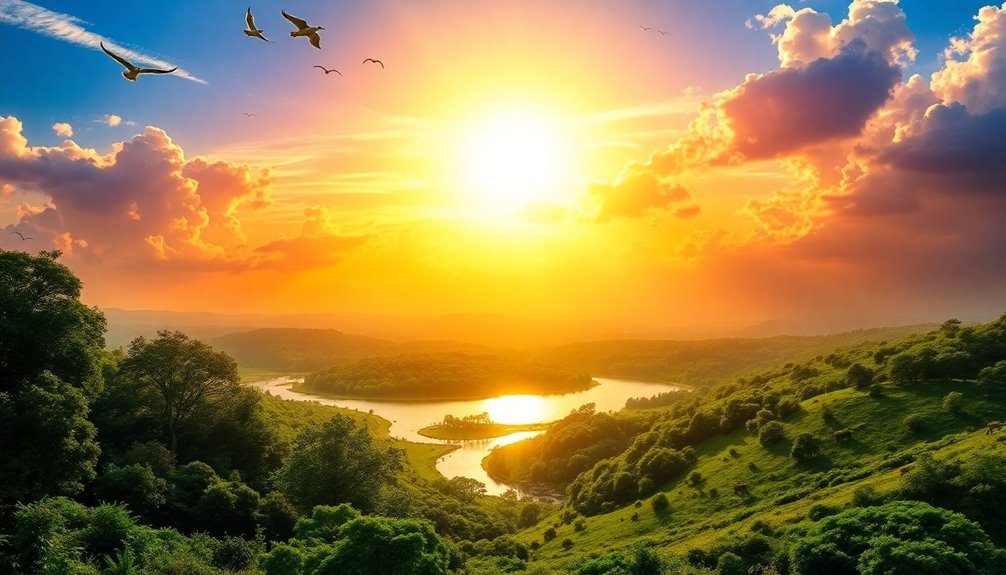
The lasting significance of creation lies in its profound implications for human identity and responsibility. In the creation narrative, God meticulously shapes the world over six days, demonstrating His sovereignty and the inherent goodness of His work. Each act of creation reflects the image of God, emphasizing that humanity shares a unique bond with the Creator. This connection invites you to recognize your role as a steward of the earth, responsible for its care and preservation.
The creation of light on the first day serves as a metaphorical illumination, revealing God's divine presence and guiding your understanding of the world around you. As you reflect on the order and beauty established in creation, you're reminded of the importance of the Sabbath, which serves as a day of rest and reflection. This sacred time underscores the significance of pausing to appreciate the world God created and to reconnect with Him.
Through the creation narrative, you gain insight into foundational beliefs that shape Judeo-Christian traditions, influencing your moral values and responsibilities. Embracing these principles helps you navigate life with purpose, grounded in the understanding of your identity as part of God's creation.
Additional Resources

Exploring the creation narrative can deepen your understanding and appreciation of God's work, and there are many resources available to enhance this journey. One of the best places to start is the Book of Genesis itself, where you can read about each of the seven days of creation. This foundational text details how God created light on Day 1, the firmament on Day 2, and dry land along with vegetation on Day 3.
For a broader perspective, consider commentaries or study guides that delve into the meanings behind these events. Many resources explain how God created the celestial bodies on Day 4 and the creatures that live in the waters and skies on Day 5.
You might also explore documentaries that visually depict the creation story, helping you to visualize the separation of waters and the emergence of dry land.
Additionally, engaging with community discussions—whether in a church group or an online forum—can provide insights from different viewpoints. Each of these resources will enrich your understanding of God's creation, allowing you to appreciate the intricate design and purpose behind the world around you.
Frequently Asked Questions
What Did God Create on Each 7 Days?
When you think about creation, you might wonder what transpired over those seven days. Each day was filled with purposeful acts, starting with light and the separation of darkness.
As you explore further, you'll discover the formation of the sky, the emergence of land and vegetation, and the establishment of celestial bodies.
Each day culminated in the creation of living beings, ultimately leading to a day of rest to complete the divine work.
What Are the 7 Days of Creation in Order for Kids?
Alright, let's break down the seven days of creation for kids!
On Day 1, God created light.
Day 2 brought the sky.
On Day 3, He formed dry land and plants.
Day 4 was all about the sun, moon, and stars.
Day 5 introduced sea creatures and birds.
Day 6, God made animals and humans.
Finally, Day 7 was a day of rest.
Isn't it amazing how everything came to be?
What Did God Do in the 6 Days of Creation?
When you explore the six days of creation, you see an incredible unfolding of life and order.
God starts by bringing light into darkness, then forms the sky and separates the waters.
You'll notice how dry land appears, filled with vegetation.
As time passes, God creates the sun, moon, and stars.
Finally, He populates the seas and skies with vibrant life.
Each day reveals a new facet of God's creative power.
What Day Did God Create Food?
When you think about when God created food, it all happened on the third day of creation. He commanded the earth to produce various plants, trees, and seeds.
You'll notice that these plants were designed to reproduce and provide sustenance. It's fascinating how God established a natural order for food, ensuring both humans and animals had what they needed to thrive.
This diversity highlights His thoughtful provision for life on Earth.


